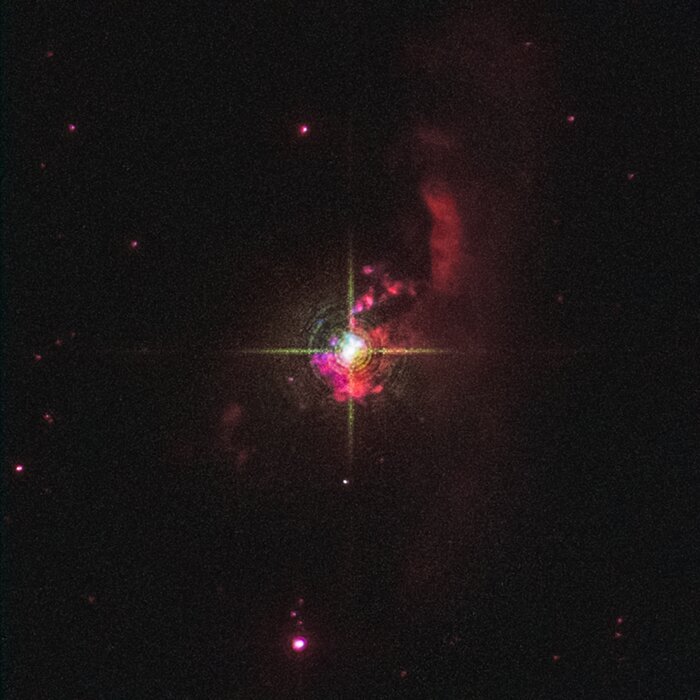Symbiotic star Mira HM Sge
This is a NASA/ESA Hubble Space Telescope image of the symbiotic star Mira HM Sge. Located 3,400 light-years away in the constellation Sagitta, it consists of a red giant and a white dwarf companion. The stars are too close together to be resolved by Hubble. Material bleeds off the red giant and falls onto the dwarf, making it extremely bright. This system first flared up as a nova in 1975. The red nebulosity is evidence of the stellar wind. The nebula is about one-quarter light-year across.
Astronomers have used new data from Hubble and the retired NASA SOFIA observatory (Stratospheric Observatory for Infrared Astronomy) as well as archival data from other missions to revisit the binary star system.
Between April and September 1975, the binary system HM Sagittae (HM Sge) grew 250 times brighter. Even more unusual, it did not rapidly fade away as novae commonly do, but has maintained its luminosity for decades. Recently, observations show that the system has gotten hotter, but paradoxically faded a little.
The 2021 ultraviolet data from Hubble showed a strong emission line of highly ionised magnesium that was not present in earlier published spectra from 1990. Its presence shows that the estimated temperature of the white dwarf and accretion disk increased from less than 220,000 degrees Celsius in 1989 to greater than 250,000 degrees Celsius now. The highly ionised magnesium line is one of many seen in the UV spectrum, which analysed together will reveal the energetics of the system, and how it has changed in the last three decades.
With data from NASA's flying telescope SOFIA, which retired in 2022, the team was able to detect the water, gas, and dust flowing in and around the system. Infrared spectral data shows that the giant star, which produces copious amounts of dust, returned to its normal behaviour within only a couple years of the explosion, but also that it has dimmed in recent years, which is another puzzle to be explained. With SOFIA astronomers were able to see water moving at around 28 kilometres per second, which they suspect is the speed of the sizzling accretion disk around the white dwarf. The bridge of gas connecting the giant star to the white dwarf must presently span about 3.2 billion kilometres.
Credit:NASA, ESA, R. Sankrit (STScI), S. Goldman (STScI), J. DePasquale (STScI)
About the Image
About the Object
| Name: | HM Sge |
|---|---|
| Distance: | 3400 light years |
| Constellation: | Sagitta |
| Category: | Stars |
Classic Wallpapers
Coordinates
| Position (RA): | 19 41 57.08 |
|---|---|
| Position (Dec): | 16° 44' 39.67" |
| Field of view: | 0.45 x 0.45 arcminutes |
| Orientation: | North is 0.5° left of vertical |
Colours & filters
| Band | Wavelength | Telescope |
|---|---|---|
| Optical O III | 502 nm |
Hubble Space Telescope
WFC3 |
| Optical H-alpha | 656 nm |
Hubble Space Telescope
WFC3 |
| Optical N II | 658 nm |
Hubble Space Telescope
WFC3 |


